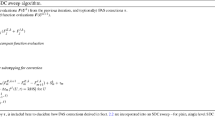Abstract
It has been demonstrated that spectral deferred correction (SDC) methods can achieve arbitrary high order accuracy and possess good stability properties. There have been some recent interests in using high-order Runge-Kutta methods in the prediction and correction steps in the SDC methods, and higher order rate of convergence is obtained provided that the quadrature nodes are uniform. The assumption of the use of uniform mesh has a serious practical drawback as the well-known Runge phenomenon may prevent the use of reasonably large number of quadrature nodes. In this work, we propose a modified SDC methods with high-order integrators which can yield higher convergence rates on both uniform and non-uniform quadrature nodes. The expected high-order of accuracy is theoretically verified and numerically demonstrated.



Similar content being viewed by others
References
Brunner, H.: Collocation Methods for Volterra Integral and Related Functional Equations. Cambridge University Press, Cambridge (2004)
Christlieb, A., Ong, B., Qiu, J.: Spectral deferred correction methods with high order Runge-Kutta schemes in prediction and correction steps. Commun. Appl. Math. Comput. Sci. 4, 27–56 (2009)
Christlieb, A., Ong, B., Qiu, J.: A comment on high order corrections within spectral deferred correction methods. Math. Comput. 79, 761–783 (2010)
Dutt, A., Greengard, L., Rokhlin, V.: Spectral deferred correction methods for ordinary differential equations. BIT Numer. Math. 40(2), 241–266 (2000)
Hansen, A., Strain, J.: On the order of deferred correction. Appl. Numer. Math. 61(8), 961–973 (2011)
Layton, A.T.: On the choice of correctors for semi-implicit Picard deferred correction methods. Appl. Numer. Math. 58(6), 845–858 (2008)
Layton, A.T., Minion, M.L.: Implications of the choice of quadrature nodes for Picard integral deferred corrections methods for ordinary differential equations. BIT Numer. Math. 45, 341–373 (2005)
Layton, A.T., Minion, M.L.: Implications of the choice of predictors for semi-implicit Picard integral defferred correction methods. Commun. Appl. Math. Comput. Sci. 2(1), 1–34 (2006)
Skell, R.D.: A theoretical framework for proving accuracy results for deferred corrections. SIAM J. Numer. Anal. 19, 171–196 (1982)
Stetter, H.J.: Analysis of Discretization Methods for ODEs. Springer, Berlin (1973)
Tang, T., Xu, X.: Accuracy enhancement using spectral postprocessing for differential equations and integral equations. Commun. Comput. Phys. 5(2–4), 779–792 (2009)
Acknowledgements
The first author thanks the useful discussions with Professors Chi-Wang Shu, John Strain and Jing-Mei Qiu. We are also grateful for Prof. Qiu for kindly providing us some relevant codes. This research was supported by Hong Kong Research Grants Council and Hong Kong Baptist University.
The second author is supported by the Croucher Foundation of Hong Kong, the National Nature Science Foundation of China (11001259), the National Center for Mathematics and Interdisciplinary Science, CAS and the President Foundation of AMSS-CAS.
The third author is supported by the National Science Foundation of China (11126215, 11201167).
Author information
Authors and Affiliations
Corresponding author
Rights and permissions
About this article
Cite this article
Tang, T., Xie, H. & Yin, X. High-Order Convergence of Spectral Deferred Correction Methods on General Quadrature Nodes. J Sci Comput 56, 1–13 (2013). https://doi.org/10.1007/s10915-012-9657-9
Received:
Revised:
Accepted:
Published:
Issue Date:
DOI: https://doi.org/10.1007/s10915-012-9657-9




